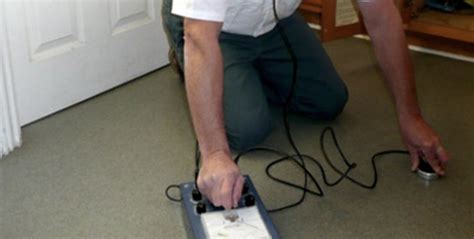Slab Leak Detection

Slab leak detection is a crucial process for identifying and addressing leaks in the water pipes that run beneath a home's foundation, known as a slab. These leaks can lead to significant water damage, increased utility bills, and even structural issues if left undetected or unrepaired. The detection of slab leaks requires specialized equipment and expertise, as the pipes are embedded in the concrete slab and not easily accessible. In this article, we will delve into the world of slab leak detection, exploring the causes, symptoms, methods, and importance of early detection.
Key Points
- Slab leaks can cause significant water damage and structural issues if left undetected or unrepaired.
- Early detection is crucial to prevent costly repairs and minimize damage.
- Specialized equipment, such as leak detection cameras and acoustic sensors, is used to detect slab leaks.
- Non-invasive detection methods, like thermal imaging, can help identify leaks without damaging the property.
- Regular maintenance and inspections can help prevent slab leaks and detect potential issues early on.
Causes and Symptoms of Slab Leaks

Slab leaks can occur due to various factors, including corrosion, poor installation, and soil movement. Corrosion is a common cause of slab leaks, as the pipes can deteriorate over time, leading to small cracks and holes. Poor installation, such as improper pipe sizing or inadequate support, can also contribute to slab leaks. Soil movement, which can be caused by earthquakes, soil settlement, or other geological events, can put stress on the pipes, leading to cracks and leaks. The symptoms of slab leaks can be subtle, but they often include increased water bills, damp or wet spots on the floor, and the sound of running water when no faucets are in use.
Methods of Slab Leak Detection
There are several methods of slab leak detection, each with its own advantages and limitations. One common method is the use of leak detection cameras, which can be inserted into the pipes to visually inspect for leaks. Acoustic sensors can also be used to detect the sound of running water, which can help locate the source of the leak. Thermal imaging is another non-invasive method that can help identify leaks by detecting temperature differences in the slab. This method is particularly useful for detecting leaks in areas where access is limited or where invasive methods could cause damage.
| Detection Method | Description |
|---|---|
| Leak Detection Cameras | Visually inspect pipes for leaks using a camera |
| Acoustic Sensors | Detect the sound of running water to locate leaks |
| Thermal Imaging | Detect temperature differences to identify leaks |

Importance of Early Detection

Early detection of slab leaks is essential to prevent costly repairs and minimize damage. If left undetected or unrepaired, slab leaks can lead to significant water damage, including warping of floors, damage to walls, and mold growth. In addition to the financial costs, slab leaks can also pose health risks, particularly if the water damage leads to mold growth. Regular maintenance and inspections can help prevent slab leaks and detect potential issues early on. This can include checking water bills for unexpected increases, inspecting the slab for signs of water damage, and using non-invasive detection methods to identify potential leaks.
Prevention and Maintenance
Prevention and maintenance are key to preventing slab leaks. Regular inspections can help identify potential issues before they become major problems. This can include checking the pipes for signs of corrosion, ensuring that the pipes are properly sized and supported, and monitoring the water pressure to prevent excessive stress on the pipes. Additionally, homeowners can take steps to prevent slab leaks, such as avoiding planting trees or shrubs with invasive roots near the slab and ensuring that the soil around the foundation is properly graded to prevent water accumulation.
What are the common causes of slab leaks?
+Slab leaks can occur due to various factors, including corrosion, poor installation, and soil movement. Corrosion is a common cause of slab leaks, as the pipes can deteriorate over time, leading to small cracks and holes.
How can I detect a slab leak?
+There are several methods of slab leak detection, including the use of leak detection cameras, acoustic sensors, and thermal imaging. These methods can help identify leaks by visually inspecting the pipes, detecting the sound of running water, or detecting temperature differences in the slab.
Why is early detection important?
+Early detection of slab leaks is essential to prevent costly repairs and minimize damage. If left undetected or unrepaired, slab leaks can lead to significant water damage, including warping of floors, damage to walls, and mold growth.
In conclusion, slab leak detection is a critical process that requires specialized equipment and expertise. By understanding the causes and symptoms of slab leaks, homeowners can take steps to prevent and detect potential issues early on. Regular maintenance and inspections can help prevent slab leaks and detect potential issues before they become major problems. With the right knowledge and tools, homeowners can protect their properties from the damaging effects of slab leaks and ensure a safe and healthy living environment.
